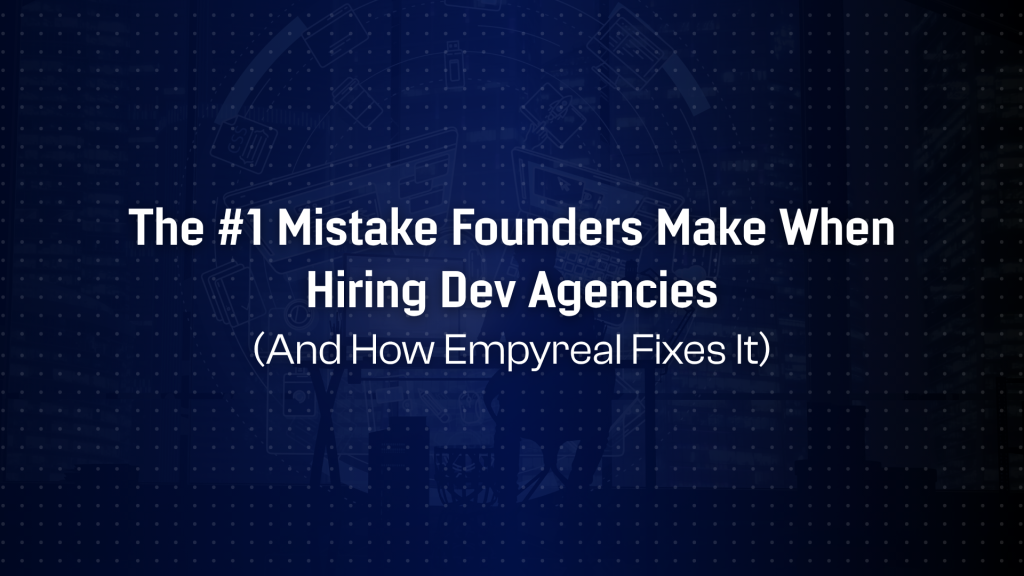Many startup founders assume that handing off development to an outside agency is a simple shortcut until reality bites. In practice, the single biggest mistake is failing to establish alignment and clarity up front. Founders often jump into contracts without defining project scope, processes or communication channels. This oversight is fatal. According to industry data, 57% of IT projects fail due to poor communication, and even well-intentioned teams can misfire when goals and methods aren’t crystal clear. The result is missed deadlines, cost overruns, and shattered expectations.
Getting specifics wrong creates a cascade of problems. Without a well-defined plan and frequent check-ins, even expert developers won’t know what to build or will build the wrong thing. Startup leaders must therefore be ultra-vigilant about scope, process, and communication from day one. In this post we’ll explore how unclear requirements, communication gaps, and process misalignment derail projects, and show how Empyreal’s approach remedies each issue with proactive best practices.
Vague Scope and Undefined Requirements
At the heart of every doomed project is often a vague or shifting scope. Founders sometimes describe features in broad strokes : “We want an app that does everything”, without spelling out priorities or constraints. The warning signs of a poor scope are classic: generic project descriptions, missing tech-stack details, and no defined goals or project scope.
When objectives aren’t clear, outsourced teams literally chase ghosts. They may code the wrong features or add needless bells and whistles, assuming more is better. Without concrete milestones, the project drifts. Poorly defined requirements lead to delays, burnout, and ultimately a sense of chaos as the team scrambles to guess what the client really wants. In short, vague goals invite scope creep and confusion.
Common signs of a murky scope: overly broad or generic briefs, missing acceptance criteria, constantly changing feature requests. When a project’s statement of work is incomplete or lacks clear timelines and objectives, it is impossible to keep the project on track.
Without a tight scope, even agile teams end up treading water. Outsourced teams may churn without making meaningful progress if requirements remain undefined or change weekly. Founders who skip writing detailed requirements set their teams up to stumble. In severe cases, this leads to building the wrong product entirely, a nightmare outcome that Empyreal’s thorough discovery process is designed to prevent.
Communication Gaps: The Silent Project Killers
Even with a clear plan, poor communication can undo your project. In global software development, every message drop or misinterpreted email adds friction. 57% of IT projects fail due to poor communication. Those failures manifest as missed expectations, rework, and delays. Misaligned assumptions may send developers coding the wrong features; an expensive mistake made worse if nobody notices until late in the project.
Typical pitfalls include infrequent status updates, no single source of truth, or worse, cultural and language barriers. A 2022 survey found 21% of companies rated communication issues as the biggest problem with their outsourcing partners. When communication breaks down, deadlines slip or tasks get duplicated. Improper communications can result in missed requirements, confusion over timelines, and redundant work. Even time-zone lags exacerbate this: two teams literally on opposite schedules can easily fall out of sync.
Without proactive measures, every assumption gap turns into a cost overrun. If critical details are lost, subtle specifics get lost in translation and the end product suffers from quality issues. Founders must assume nothing. In practice this means setting up daily stand-ups, shared documentation, and overlapping work hours. A failure to do so is a recipe for chaos. Nearly one in five projects stalled simply because teams never got on the same page.
Warning signs of a communication breakdown: no regular meetings or updates, mismatched terminology between teams, delayed feedback cycles. Development teams must be on the same wavelength regarding timelines and responsibilities. If your team isn’t reporting daily progress or if written specs keep changing without discussion, watch out.
Process & Cultural Misalignment
Beyond scope and chat, misaligned processes and culture can sabotage projects quietly. Every company has its own way of working; from workflow tools to meeting rhythms. When an outsourcing partner doesn’t adapt, friction ensues. If your organization has highly specific cultural values like radical transparency, extreme agile, or zero-defect delivery, or proprietary workflows, bringing on an external team can slow velocity and introduce friction.
Process misalignment isn’t just buzzwords; it’s a real cost. Communication silos, process misalignment, and operational inefficiencies are what really constrain software development — not coding per se. In fact, 80% of development costs come from workflow coordination and communication issues. In practice, a misaligned process means developers write perfect code at the wrong time or place: one team merges changes that another team can’t even review because they use a different CI/CD pipeline.
For example, imagine your company lives on Scrum sprints but the agency follows a waterfall roadmap. The result? One side is sprinting ahead while the other is stuck in analysis paralysis. Or maybe your in-house team uses GitHub but the vendor is on Bitbucket; then simple code handoffs become troubleshooting sessions. These invisible mismatches – conflicting documentation, disconnected issue-tracking, or different definitions of “done”, steadily erode progress. If left unchecked, they break trust and slow the entire project.
Common misalignment red flags: the development team skips your preferred ceremonies like stand-ups or demos; you’re using incompatible project management tools; differing quality standards. Potential process misalignment is a known outsourcing risk. With undefined or vague processes, outsourced teams may churn without making meaningful progress. Founders must insist on synced workflows and shared tools to avoid this silent drag.
How Empyreal Prevents It
Empyreal Infotech was built to counter exactly these pitfalls. Their secret weapon is alignment by design. First, Empyreal’s discovery process is ultra-thorough: as they state on their website, “We properly explore your niche, market, and user features” before coding a line. This in-depth scoping ensures no critical detail is missed so founders won’t be surprised later. In practice, Empyreal’s project managers work with clients to nail down requirements and use cases upfront, locking in a clear scope that virtually eliminates the “no defined goals” problem.
Second, communication is built into Empyreal’s DNA. They assign dedicated points of contact and insist on 24/7 availability. (Yes, Empyreal highlights “24×7 Availability” as a core offering.) This means your team can reach out across time zones and expect a prompt answer. Clients notice the difference: one testimonial raves that “with Mohit and his team you will find very strong communication” and a “very talented team.” In short, Empyreal doesn’t drop the ball on reporting. They run regular stand-ups and demos, so you always know exactly where the project stands.
Third, Empyreal embraces Agile project management end-to-end. Their LinkedIn page proudly says they deliver “comprehensive solutions with end-to-end project management, powered by Agile Methodology.” By using Scrum and Kanban, Empyreal keeps both sides in sync through short sprints and frequent reviews. Agile’s built-in feedback loops catch misunderstandings before they snowball. Combine that with Empyreal’s disciplined workflow, and you have two cultures singing the same song. No wonder they emphasize “dedicated resources” and “quick turnaround time” on their site, the team isn’t juggling your project with too many others.
In sum, Empyreal prevents the #1 hiring mistake by proactively filling the gaps founders often overlook. They insist on clear specs and contracts, relentless communication, and aligned processes. This is more than lip service: Empyreal’s clients themselves praise “very strong communication” and reliability. The result is that projects hit the mark on time and within budget.
To visualize Empyreal’s approach, consider these practices:
-
- 360° Discovery & Scoping: Empyreal holds detailed requirement workshops so no ambiguity remains. As they put it, they aim to “serve you with the greatest solution at the least cost” by thoroughly researching your niche.
-
- Transparent, Regular Updates: From day one you get a project manager and a fixed delivery plan. Empyreal guarantees 24×7 availability, meaning your queries never go unanswered, even across continents.
-
- Aligned Agile Process: By following Agile sprints, Empyreal keeps priorities aligned with your feedback. Their team “offers innovative, comprehensive solutions with end-to-end project management, powered by Agile”—minimizing the friction that kills so many projects.
Key Takeaways and Best Practices
Hiring a dev agency doesn’t have to be a gamble. The biggest blunder is expecting success without effort on your part. In practical terms, founders should:
-
- Define Everything Up Front: Write a clear scope of work and user stories. If you only have ideas and no specifics, demand a discovery phase. Ambiguity invites chaos.
-
- Keep Communication Lines Open: Schedule daily or weekly check-ins. Use shared tools (Slack, JIRA, etc.) so nothing falls through the cracks. Remember, a study showed one in five companies cite communication as their #1 outsourcing headache. Don’t be a statistic.
-
- Align Your Processes: Agree on a methodology from the start. If you use Agile, insist your agency does too. Choose common tools and encourage transparency. Misaligned processes “slow velocity and introduce friction”- avoid it.
-
- Pick a Partner with Guardrails Built In: Look for agencies that mandate the very solutions above. Empyreal, for example, commits to clear upfront planning, continuous client involvement, and flexible delivery. They’ve turned preventing these mistakes into their standard operating procedure.
By being laser-focused on scope, communication, process, and by choosing an agency that enforces them, founders can flip the script. The #1 mistake isn’t outsourcing itself, it’s outsourcing without safeguards. Empyreal’s experience-driven approach ensures those safeguards are always in place. The payoff is a smoother project: fewer surprises, fewer delays, and a final product that truly matches the vision you had from day one.




